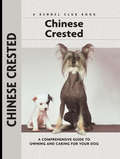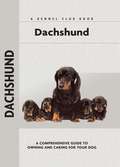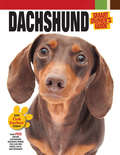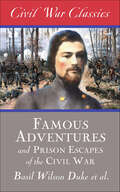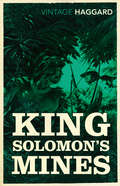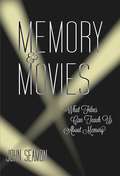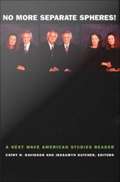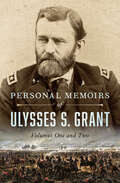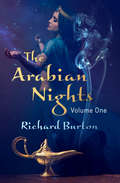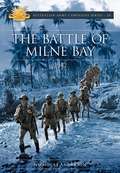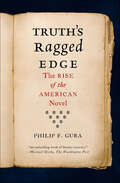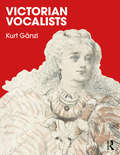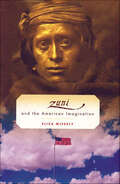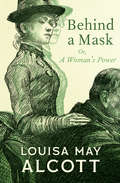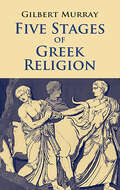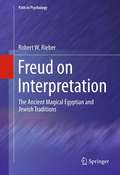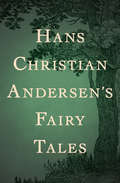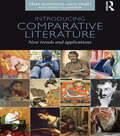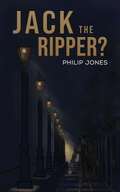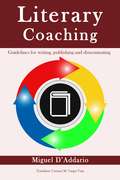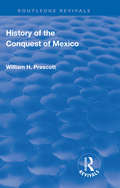- Table View
- List View
Chinese Crested
by Isabelle Francais Carol Ann Johnson Juliette CunliffeThe world's most beloved hairless dog, the Chinese Crested is distinctive for his near-nakedness, his (sometimes) lavender skin coloration, and his graceful miniature pony outline. Whether hairless with tufts of flowing hair on his feet, head, and tail or coated (referred to as Powderpuff), the Chinese Crested makes a loyal, enthusiastic companion for anyone clever enough to fall under the spell of this elegant toy breed. Author Juliette Cunliffe provides insightful chapters on the breed's history, the evolution of hairless dogs, and the characteristics that make the Chinese Crested such a unique dog among dogs.New owners will welcome the well-prepared chapter on finding a reputable breeder and selecting a healthy, sound puppy. Chapters on puppy-proofing the home and yard, purchasing the right supplies for the puppy as well as house-training, feeding, and grooming (of skin and coat) and tooth care are illustrated with photographs of handsome adults and puppies. In all, there are over 135 full-color photographs in this useful and reliable volume. The author's advice on obedience training will help the reader better mold and train into the most well-mannered dog in the neighborhood. The extensive and lavishly illustrated chapter on healthcare provides up-to-date detailed information on selecting a qualified veterinarian, vaccinations, preventing and dealing with parasites, infectious diseases, and more. Sidebars throughout the text offer helpful hints, covering topics as diverse as historical dogs, breeders, or kennels, toxic plants, first aid, crate training, carsickness, fussy eaters, and parasite control. Fully indexed.
Dachshund
by Ingrid SchwartzFew breeds trigger as much pride as the Dachshund, as only Dachshund people understand why this breed is superior to all others! Any Dachshund owner will explain it to you, as will author Ingrid Schwartz, an owner of Dachshunds for many generations. This Comprehensive Owner's Guide dedicated to Germany's Teckel (or weiner dog, as he's sometimes affectionately called) paints a vivid portrait of this dwarf-sized scenthound originally bred to hunt badger, surely a calling that requires a determined, feisty fellow. Although many Dachshund folk deny it (you can't blame them for their loyalty), Dachshunds may be the most stubborn canines on the planet and they're not for everyone, even though there are many varieties to choose from. The chapter dedicated to the breed's characteristics discusses not only the breed's two sizes and three coat types but also its comical, intelligent, and determined personality.New owners will welcome the well-prepared chapter on finding a reputable breeder and selecting a healthy, sound puppy. Chapters on puppy-proofing the home and yard, purchasing the right supplies for the puppy as well as house-training, feeding, and grooming (all three coat types) are illustrated with photographs of handsome adults and puppies. In all, there are over 135 full-color photographs in this useful and reliable volume. The author's advice on obedience training will help the reader better mold and train into the most well-mannered dog in the neighborhood. The extensive and lavishly illustrated chapter on healthcare provides up-to-date detailed information on selecting a qualified veterinarian, vaccinations, preventing and dealing with parasites, infectious diseases, and more. Sidebars throughout the text offer helpful hints, covering topics as diverse as historical dogs, breeders, or kennels, toxic plants, first aid, crate training, carsickness, fussy eaters, and parasite control. Fully indexed.
Dachshund
by Dog Fancy MagazineDedicated to the one-of-a-kind Dachshund, known for his elongated construction, his unstoppable nose, and his gallons of personality, this Smart Owner's Guide, created by the editors at Dog Fancy magazine, offers the most up-to-date and accurate information every dog owner needs to become a well-informed caregiver for his dog. Illustrated with color photographs of adorable puppies and handsome adults, this easy-to-read primer is designed in a modern, lively manner that readers will find user-friendly and entertaining.Each Smart Owner's Guide offers a description of the breed's character and physical conformation, historical overview, and its attributes as a companion dog. The reader will find informative chapters on everything he or she needs to know about acquiring, raising, and training this remarkable purebred dog, including: finding a breeder and selecting a healthy, sound puppy; preparing for the puppy's homecoming, shopping for supplies, and puppy-proofing the home; house-training; veterinary and home health maintenance; feeding and nutrition; and grooming. Obedience training for basic cues (sit, stay, heel, come, etc.) and solving potential problem behaviors (barking, chewing, aggression, jumping up, etc.) are addressed in separate chapters, as are activities to enjoy with the dog, including showing, agility, therapy work, and more.Entertaining tidbits and smart advice fill up colorful sidebars in every chapter, which the editors call "It's a Fact," "Smart Tip," "Notable & Quotable," and "Did You Know?" Real-life heroes and rescue stories are retold in full-page features called "Pop Pups" and "True Tails." Recipes, training, and care tips are highlighted in the "Try This" feature pages.The Smart Owner's Guide series is the only series that offers readers an online component in which dog owners can join a breed-specific online club hosted by dogchannel.com. At Club Dachsie, owners of the breed can find forums, blogs, and profiles to connect with other breed owners, as well as charts and checklists that can be downloaded. More than just 20,000 pages of solid information, there's a host of fun to be had at the club in the form of downloadable breed-specific e-cards, screensavers, games, and quizzes.The Resources section of the book includes contact information for breed-related organizations and rescues, as well as practical guidance on traveling with dogs, identification, and locating qualified professionals to assist the dog owner, such as pet sitters, trainers, and boarding facilities. This information-packed Smart Owner's Guide is fully indexed.
Famous Adventures and Prison Escapes of the Civil War (Civil War Classics)
by Basil Wilson DukeTo commemorate the 150th Anniversary of the end of the Civil War, Diversion Books is publishing seminal works of the era: stories told by the men and women who led, who fought, and who lived in an America that had come apart at the seams. For those who did not die on the battlefield, but who were instead taken prisoner, the Civil War presented an even more intense version of hell. Prison conditions were abysmal, and the prisoners frequently died of starvation and disease. These accounts of prison escapes show what desperate men will do, fleeing unequivocal peril to land behind enemy lines, struggling to get back to their own side and live to fight another day. Searing and difficult, this account puts readers into the minds of men at the precipice, willing to risk death for freedom.
King Solomon's Mines
by Rider HaggardAllan Quatermain is a Victorian Indiana Jones - he triumphs over deserts, snowy mountains, tribal warfare and witches, and unearths the mythical treasure of King Solomon's mines. This faithful but unpretending record of a remarkable adventure is hereby respectfully dedicated by the narrator to all the big boys and little boys who read it. I offer apologies for my blunt way of writing. I can but say in excuse of it that I am more accustomed to handling a rifle than a pen. This is the strange history of our journey into the heart of Kukuanaland; a trek into the interior of the dark continent to find a lost friend and discover the diamond mines of King Solomon.In the course of a long life of close shaves, I never had such shaves as those which I have recently experienced. - Allan Quatermain, of Durban, Natal, Gentleman ‘One of the great page-turners in English literature’ Guardian
Memory and Movies
by John SeamonIn the movie Slumdog Millionaire, the childhood memories of a young game show contestant trigger his correct answers. In Memento, the amnesiac hero uses tattoos as memory aids. In Away from Her, an older woman suffering from dementia no longer remembers who her husband is. These are compelling films that tell affecting stories about the human condition. But what can these movies teach us about memory? In this book, John Seamon shows how examining the treatment of memory in popular movies can shed new light on how human memory works. After explaining that memory is actually a diverse collection of independent systems, Seamon uses examples from movies to offer an accessible, nontechnical description of what science knows about memory function and dysfunction. In a series of lively encounters with numerous popular films, he draws on Life of Pi and Avatar, for example, to explain working memory, used for short-term retention. He describes the process of long-term memory with examples from such films as Cast Away and Groundhog Day; The Return of Martin Guerre, among other movies, informs his account of how we recognize people; the effect of emotion on autobiographical memory is illustrated by The Kite Runner, Titanic, and other films; movies including Born on the Fourth of July and Rachel Getting Married illustrate the complex pain of traumatic memories. Seamon shows us that movies rarely get amnesia right, often using strategically timed blows to the protagonist's head as a way to turn memory off and then on again (as in Desperately Seeking Susan). Finally, he uses movies including On Golden Pond and Amour to describe the memory loss that often accompanies aging, while highlighting effective ways to maintain memory function.
No More Separate Spheres!: A Next Wave American Studies Reader
by Cathy N. Davidson Jessamyn HatcherNo More Separate Spheres! challenges the limitations of thinking about American literature and culture within the narrow rubric of "male public" and "female private" spheres from the founders to the present. With provocative essays by an array of cutting-edge critics with diverse viewpoints, this collection examines the ways that the separate spheres binary has malingered unexamined in feminist criticism, American literary studies, and debates on the public sphere. It exemplifies new ways of analyzing gender, breaks through old paradigms, and offers a primer on feminist thinking for the twenty-first century. Using American literary studies as a way to talk about changing categories of analysis, these essays discuss the work of such major authors as Catharine Sedgwick, Herman Melville, Pauline E. Hopkins, Frederick Douglass, Catharine Beecher, Ralph Waldo Emerson, W. E. B. Du Bois, Sarah Orne Jewett, Nathaniel Hawthorne, María Ampara Ruiz de Burton, Ann Petry, Gwendolyn Brooks, Cynthia Kadohata, Chang Rae-Lee, and Samuel Delany. No More Separate Spheres! shows scholars and students different ways that gender can be approached and incorporated into literary interpretations. Feisty and provocative, it provides a forceful analysis of the limititations of any theory of gender that applies only to women, and urges suspicion of any argument that posits "woman" as a universal or uniform category. By bringing together essays from the influential special issue of American Literature of the same name, a number of classic essays, and several new pieces commissioned for this volume, No More Separate Spheres! will be an ideal teaching tool, providing a key supplementary text in the American literature classroom. Contributors. José F. Aranda, Lauren Berlant, Cathy N. Davidson, Judith Fetterley, Jessamyn Hatcher, Amy Kaplan, Dana D. Nelson, Christopher Newfield, You-me Park, Marjorie Pryse, Elizabeth Renker, Ryan Schneider, Melissa Solomon, Siobhan Somerville, Gayle Wald , Maurice Wallace
Oscar Wilde and Ancient Greece
by Iain RossFrom his boyhood Oscar Wilde was haunted by the literature and culture of ancient Greece, but until now no full-length study has considered in detail the texts, institutions and landscapes through which he imagined Greece. The archaeology of Celtic Ireland, explored by the young Wilde on excavations with his father, informed both his encounter with the archaeology of Greece and his conviction that Celt and Greek shared a hereditary aesthetic sensibility, while major works such as The Picture of Dorian Gray and The Importance of Being Earnest maintain a dynamic, creative relationship with originary texts such as Aristotle's Ethics, Plato's dialogues and the then lost comedies of Menander. Drawing on unpublished archival material, Oscar Wilde and Ancient Greece offers a new portrait of a writer whose work embodies both the late-nineteenth-century conflict between literary and material antiquity and his own contradictory impulses towards Hellenist form and the formlessness of desire.
Personal Memoirs of Ulysses S. Grant: Volumes One and Two (Barnes And Noble Library Of Essential Reading)
by Ulysses S. GrantThe celebrated remembrances of the man who led the Union to victory during the Civil WarCompleted just days before his death, Grant&’s Personal Memoirs is a clear and compelling account of his military career, focusing on two great conflicts: the Mexican-American War and the Civil War. Lauded for its crisp and direct prose, Grant&’s autobiography offers frank insight into everything from the merits of the war with Mexico to the strategies and tactics employed by Union forces against the Confederacy to the poignancy of Grant&’s meeting with General Lee at Appomattox Court House.Beloved and bestselling since its publication in 1885, Personal Memoirs of Ulysses S. Grant is a seminal work of military history and one of the great achievements of American autobiography.This ebook has been professionally proofread to ensure accuracy and readability on all devices.
Pug
by Dog Fancy MagazineDedicated to the Pug, the biggest dog in a toy-dog package, this Smart Owner's Guide, created by the editors at Dog Fancy magazine, offers the most up-to-date and accurate information every dog owner needs to become a well-informed caregiver for his dog. Illustrated with color photographs of adorable puppies and handsome adults, this easy-to-read primer is designed in a modern, lively manner that readers will find user-friendly and entertaining.Each Smart Owner's Guide offers a description of the breed's character and physical conformation, historical overview, and its attributes as a companion dog. The reader will find informative chapters on everything he or she needs to know about acquiring, raising, and training this remarkable purebred dog, including: finding a breeder and selecting a healthy, sound puppy; preparing for the puppy's homecoming, shopping for supplies, and puppy-proofing the home; house-training; veterinary and home health maintenance; feeding and nutrition; and grooming. Obedience training for basic cues (sit, stay, heel, come, etc.) and solving potential problem behaviors (barking, chewing, aggression, jumping up, etc.) are addressed in separate chapters, as are activities to enjoy with the dog, including showing, agility, therapy work, and more.Entertaining tidbits and smart advice fill up colorful sidebars in every chapter, which the editors call "It's a Fact," "Smart Tip," "Notable & Quotable," and "Did You Know?" Real-life heroes and rescue stories are retold in full-page features called "Pop Pups" and "True Tails." Recipes, training, and care tips are highlighted in the "Try This" feature pages.The Smart Owner's Guide series is the only series that offers readers an online component in which dog owners can join a breed-specific online club hosted by dogchannel.com. At Club Pug, owners of the breed can find forums, blogs, and profiles to connect with other breed owners, as well as charts and checklists that can be downloaded. More than just 20,000 pages of solid information, there's a host of fun to be had at the club in the form of downloadable breed-specific e-cards, screensavers, games, and quizzes.The Resources section of the book includes contact information for breed-related organizations and rescues, as well as practical guidance on traveling with dogs, identification, and locating qualified professionals to assist the dog owner, such as pet sitters, trainers, and boarding facilities. This information-packed Smart Owner's Guide is fully indexed.
The Arabian Nights Volume One: More Marvels And Wonders Of The Thousand And One Nights (The Arabian Nights #1)
by Richard BurtonThe first volume of the classic collection of Middle Eastern stories, including &“Tale of the Three Apples&” and &“Tale of the Trader and the Jinni.&” To be chosen by King Shahriyar as a wife was a death sentence. After a single night of marriage, he executed each of his wives. So when Scheherazade was picked, she knew her time on Earth had reached its end—unless she could hold the king&’s interest. To that end, each night she spun a new enchanting, erotic, mesmerizing tale, always keeping the king guessing as to its conclusion—and sparing her life for another thousand and one nights. The first volume of this collection, translated by the renowned British explorer Sir Richard Burton, begins the stories that Scheherazade told . . .
The Battle of Milne Bay 1942 (Australian Army Campaigns Series #24)
by Nicholas AndersonBy 1942 the formidable Japanese military had conquered swathes of territory across south-east Asia and the Pacific Ocean. Despite its defeat at the Battle of Midway, Japan remained a potent enemy committed to the creation of a defensive arc to shield its captured possessions in the Pacific. The capture of Port Moresby would cement the southern border of this defensive arc and sever the vital lines of communication between Australia and the United States. It was the Japanese plan to seize Moresby that would set the course for the Battle of Milne Bay. Situated on the eastern tip of New Guinea, Milne Bay was a wretched hell-hole: swamp-riddled, a haven for malaria and cursed with torrential rain. It was here that General Douglas MacArthur ordered the secret construction of an Allied base with airfields to protect the maritime approach to Port Moresby. But the Japanese soon discovered the base at Milne Bay and despatched a task force to destroy its garrison and occupy the base. All that stood between the Japanese and their prize was a brigade of regular Australian soldiers untrained in tropical warfare and a brigade of Australian militia with no combat experience whatsoever. While the Kokoda campaign is etched in public memory, its sister battle at Milne Bay has long been neglected. However the bitter fighting over this isolated harbour played an equally important role in protecting Port Moresby and made a valuable contribution to shifting Allied fortunes in the Pacific War.
Truth's Ragged Edge: The Rise of the American Novel
by Philip F. GuraFrom the acclaimed cultural historian Philip F. Gura comes Truth's Ragged Edge, a comprehensive and original history of the American novel's first century. Grounded in Gura's extensive consideration of the diverse range of important early novels, not just those that remain widely read today, this book recovers many long-neglected but influential writers—such as the escaped slave Harriet Jacobs, the free black Philadelphian Frank J. Webb, and the irrepressible John Neal—to paint a complete and authoritative portrait of the era. Gura also gives us the key to understanding what sets the early novel apart, arguing that it is distinguished by its roots in "the fundamental religiosity of American life." Our nation's pioneering novelists, it turns out, wrote less in the service of art than of morality.This history begins with a series of firsts: the very first American novel, William Hill Brown's The Power of Sympathy, published in 1789; the first bestsellers, Susanna Rowson's Charlotte Temple and Hannah Webster Foster's The Coquette, novels that were, like Brown's, cautionary tales of seduction and betrayal; and the first native genre, religious tracts, which were parables intended to instruct the Christian reader. Gura shows that the novel did not leave behind its proselytizing purpose, even as it evolved. We see Catharine Maria Sedgwick in the 1820s conceiving of A New-England Tale as a critique of Puritanism's harsh strictures, as well as novelists pushing secular causes: George Lippard's The Quaker City, from 1844, was a dark warning about growing social inequality. In the next decade certain writers—Hawthorne and Melville most famously—began to depict interiority and doubt, and in doing so nurtured a broader cultural shift, from social concern to individualism, from faith in a distant god to faith in the self.Rich in subplots and detail, Gura's narrative includes enlightening discussions of the technologies that modernized publishing and allowed for the printing of novels on a mass scale, and of the lively cultural journals and literary salons of early nineteenth-century New York and Boston. A book for the reader of history no less than the reader of fiction, Truth's Ragged Edge—the title drawn from a phrase in Melville, about the ambiguity of truth—is an indispensable guide to the fascinating, unexpected origins of the American novel.
Victorian Vocalists
by Kurt GanzlVictorian Vocalists is a masterful and entertaining collection of 100 biographies of mid- to late-19th-century singers and stars. Kurt Gänzl paints a vivid picture of the Victorian operatic and concert world, revealing the backgrounds, journeys, successes, failures and misdemeanours of these singers. This volume is not only an outstanding reference work for anyone interested in vocalists of the era, but also a compelling, meticulously researched picture of life in the vast shark tank that was Victorian music.
Zuni and the American Imagination
by Eliza McFeelyA bold new study of the Zuni, of the first anthropologists who studied them, and of the effect of Zuni on America's sense of itselfThe Zuni society existed for centuries before there was a United States, and it still exists in its desert pueblo in what is now New Mexico. In the late nineteenth century, anthropologists-among the first in this new discipline-came to Zuni to study it and, they believed, to salvage what they could of its tangible culture before it was destroyed, which they were sure would happen. Matilda Stevenson, Frank Hamilton Cushing, and Stewart Culin were the three most important of these early students of Zuni, and although modern anthropologists often disparage and ignore their work-sometimes for good, sometimes for poor reasons-these pioneers gave us an idea of the power and significance of Zuni life that has endured into our time. They did not expect the Zuni themselves to endure, but they have, and the complex relation between the Zuni as they were and are and the Zuni as imagined by these three Easterners is at the heart of Eliza McFeely's important new book.Stevenson, Cushing, and Culin are themselves remarkable subjects, not just as anthropology's earliest pioneers but as striking personalities in their own right, and McFeely gives ample consideration, in her colorful and absorbing study, to each of them. For different reasons, all three found professional and psychological satisfaction in leaving the East for the West, in submerging themselves in an alien and little-known world, and in bringing back to the nation's new museums and exhibit halls literally thousands of Zuni artifacts. Their doctrines about social development, their notions of "salvage anthropology," their cultural biases and predispositions are now regarded with considerable skepticism, but nonetheless their work imprinted Zuni on the American imagination in ways we have yet to measure. It is the great merit of McFeely's fascinating work that she puts their intellectual and personal adventures into a just and measured perspective; she enlightens us about America, about Zuni, and about how we understand each other.
Behind a Mask: Or, A Woman's Power (Mobi Classics Series)
by Louisa May Alcott<p>An early novel of gothic thrills and chills from the beloved author of Little Women.<p> <p>One of four stories written under the penname A. M. Barnard, Behind a Mask was originally published in 1866 for a young adult audience. Set in Victorian-era Britain, it follows the machinations of Jean Muir, a governess hired by the Coventry family to care for their sixteen-year-old daughter. Winning the confidence of the clan proves easy for Jean, though she does raise some suspicion. And rightly so. Behind closed doors—and beneath her brilliant disguise—Jean reveals her true identity: a cunning and ambitious actress whose goal is nothing less than securing the Coventry family’s estate and fortune for herself.<p>
El libro de los muertos (Doctora Kay Scarpetta #Volumen 15)
by Patricia CornwellEn la decimoquinta entrega de la serie policíaca protagonizada por la brillante y mordaz doctora Kay Scarpetta, la forense se ha instalado en Charleston, donde ha establecido un moderno laboratorio en el que trabaja con su equipo: su sobrina Lucy Faranelli, Rose y Pete Marino. En esta ocasión, Scarpetta viaja a Italia para investigar la cruel muerte de Drew Martin, una joven y famosa tenista cuyo cuerpo mutilado ha aparecido en el venerable centro histórico de Roma. El asesino es apodado el Hombre de Arena por el macabro residuo que deja, una de las escasas pistas halladas en la escena del crimen. Las contradictorias pruebas dejan estupefactos a Scarpetta, a Benton Wesley (psicólogo forense amante de la doctora) y a los carabinieri italianos. Pronto, Scarpetta y Wesley descubren una inquietante conexión entre la muerte de la tenista y el cuerpo no identificado de un joven en Carolina del Sur. Todo indica que se enfrentan a un asesino más mortífero de lo habitual.
Five Stages of Greek Religion: The History Of The Olympian Gods Of Ancient Greece (hardcover)
by Gilbert MurrayBeginning with Greece's earliest rites, this volume traces the development of the classic religion of the Olympian gods and discusses the religion of the philosophic schools of the fourth century BC. It portrays the emergence of Christianity and concludes with an account of the efforts of Julian the Apostate to restore a new variety of paganism.
Freud on Interpretation
by Robert W RieberThis book presents new insights into Freud's famous "discovery" of the unconscious and the subsequent development of psychoanalytic theories. The authors explore the original context in which these ideas arose and the central debate about mind as matter or something that transcends matter. In the course of this examination, it is demonstrated that Freud was influenced not only by the 19th century scientific milieu, but also by ancient cultures. While it is known that Freud was an avid collector of ancient artifacts and generally interested in these older cultures, this book systematically investigates their profound effect on his thinking and theorizing. Two major influences, Egyptian mythology and Jewish mysticism are analyzed in terms of similarities to Freud's emerging ideas about the mind and its diseases. To further this line of investigation, Bakan supplies an illuminating discussion of what it means to interpret. Taken from the viewpoint that interpretation involves an u
Hans Christian Andersen's Fairy Tales: The Ugly Duckling, Thumbelina, And Other Stories (First Avenue Classics Ser.)
by Hans Christian AndersenEighteen enduring fables from one of the world&’s best-loved storytellersHans Christian Andersen&’s fairy tales have long delighted millions of readers, young and old, and inspired myriad film, stage, and musical adaptations. This collection, including beloved classics &“The Emperor&’s New Clothes,&” &“The Snow Queen&” (the basis for the blockbuster film Frozen), and &“The Little Match Girl,&” is the perfect introduction to Andersen&’s groundbreaking use of plain language and realistic settings to explore life&’s great mysteries. Inspired by the ancient Danish legends and stories from Arabian Nights that his father told him, Andersen composed his fables to be read aloud, and approached difficult subjects and complex truths with a directness that children and adults still find refreshing nearly two centuries later.From &“The Red Shoes&” to &“The Dream of Little Tuk,&” this selection of Hans Christian Andersen fairy tales is a must-have for readers who already know his work by heart, and those discovering the singular power of his imagination for the very first time.This ebook has been professionally proofread to ensure accuracy and readability on all devices.
Introducing Comparative Literature: New Trends and Applications
by Haun Saussy César Domínguez Darío VillanuevaIntroducing Comparative Literature is a comprehensive guide to the field offering clear, concise information alongside useful analysis and examples. It frames the introduction within recent theoretical debates and shifts in the discipline whilst also addressing the history of the field and its practical application. Looking at Comparative Literature within the context of globalization, cosmopolitanism and post or transnationalism, the book also offers engagement and comparison with other visual media such as cinema and e-literature. The first four chapters address the broad theoretical issues within the field such as 'interliterary theory', decoloniality, and world literature, while the next four are more applied, looking at themes, translation, literary history and comparison with other arts. This engaging guide also contains a glossary of terms and concepts as well as a detailed guide to further reading.
Jack the Ripper?
by Philip JonesReaders are transported to Victorian London and introduced to Inspector Doyle, a modern-day detective with eternal life, who discovers that he has been wrongly named as ‘Jack the Ripper’, the Victorian serial killer. Nobody wants that label at any time in history, so with the aid of time travel he returns to the year 1888 in an attempt to clear his name. Another complication for Inspector Doyle is that his modern-day daughter, Flora, who he has left behind to travel back several centuries, is becoming increasingly suspicious of her father’s identity. This is after making her way into his Shrewsbury study, that she is forbidden to enter. The only good thing about returning to 1888 is that Inspector Doyle is able to rekindle his relationship with daughter Alice and wife Eleanor, who he had to leave behind all those centuries ago. Alice can then only but marvel at her father’s abilities to answer a question that only he knows the answer to, because he has travelled into the future and back. The story references many Victorian objects that have been meticulously researched and then used to tell a story that is only possible through time travel and a rather clever inventor who may or may not be still alive. Many elements of the original Jack the Ripper case are also detailed as are the horrors of Whitechapel. Find out whether Inspector Doyle manages to clear his name by discovering who the real Jack the Ripper is, and expect a twist at the end that involves both daughters and a Victorian book that, unlike the rest of Inspector Doyle’s objects, is unable to exist in parallel between the two time zones.
Jo's Boys: How They Turned Out
by Louisa May AlcottThis sequel to Alcott's "Little Women" and "Little Men" chronicles the return of the classmates of Plumfield, Jo's school for boys. Readers re-encounter Nat, the orphaned street musician, now a conservatory student; restless Dan, back from the gold mines of California; business-minded Tom; and other old friends.
Literary Coaching - Guidelines for writing, publishing and disseminating
by Miguel D'AddarioWriting is a vocation, born of a need of each person. It is an inner manifestation, a communicational expression, be it artistic, scientific or of another literary genre. It is a property of the human being, communication through writing. This means that each one will do it in their own way and form, in the same way that each reader will interpret the content of a book, magazine or other, in a different way, understanding according to their own abilities and knowledge. San Buenaventura de Bagnoregio, wrote in the thirteenth century, that there were four ways to make a book: 1. Being a Scribe (Scriptor): Someone who writes the works of others without adding, changing or removing anything from the original text. 2. Being a Compiler (Compilator): Someone who writes works of others with additions that are not his (also others). 3. Being a Commentator (Comentator): Someone who writes the works of others and their own, giving them the primary place to the works of others with clarifying aggregates. 4. Being an Author (Auctor): Someone who writes his own works and others, but giving the primary place to his writings and adding others to assert his own text. Therefore, a person who writes is, in short, an Author, regardless of whether he has published his work or not. And the difference lies in the legal nature that the company manages by identifying each work, the ISBN. This number makes up the legal nature of a publication, and inserts this work in the international bibliographic bases, it is the identity document of each book.
Revival: With a Preliminary View of the Ancient Mexican Civilisation and the Life of the Conqueror, Hernando Cortes (Routledge Revivals)
by William H PrescottA dramatic account of the conquest of Mexico, from first contact with the Aztec civilisation through to Cortes' expulsion and subsequent career. The book is not only interesting for the historic content withe relevance to Latin America to this day, but also as a notable example of historical scholarship and of English literature in general.
